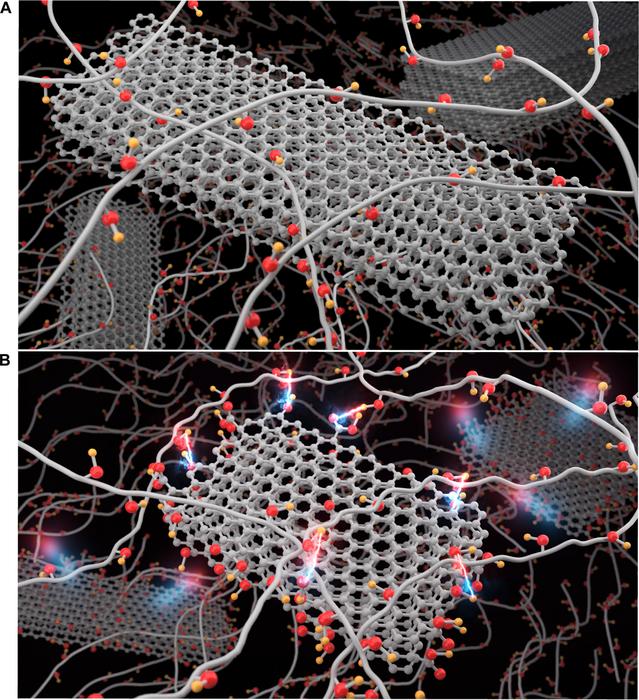In an intriguing exploration of materials science, a collaborative research team led by the University of Massachusetts Amherst has recently demonstrated a radical shift in the understanding of thermo-conductive polymers. Traditional wisdom has long suggested that the inclusion of perfect thermally conductive fillers is the most effective method for enhancing the heat dissipation capabilities of polymers. However, this new study reveals a surprising and counterintuitive finding: polymers integrated with flawed fillers, specifically graphite oxide, exhibit significantly superior thermal performance compared to those using flawless graphite.
The study, published in the esteemed journal Science Advances, casts doubt on the established paradigm within materials engineering. It was determined that polymers with defective fillers performed an astonishing 160% better in terms of thermal conductivity than those with their perfect counterparts. This breakthrough has the potential to reshape approaches in the development of polymer composites that prioritize efficient heat transfer, marking a pivotal moment in the quest for advanced materials needed in modern technological applications.
Polymers are widely recognized for their lightweight and flexible characteristics, making them a staple in a multitude of devices ranging from high-speed microchips to portable electronics. Despite their advantages, most polymers are inherently thermal insulators, creating significant challenges regarding overheating and performance degradation in electronic devices. The high prevalence of heat-induced malfunctions has underscored the urgency in enhancing thermal conductivity in these materials, prompting extensive exploration within the field of materials science.
The inclusion of highly conductive fillers, such as metals, ceramics, and carbon composites, has long been considered a straightforward and effective method to improve thermal performance. Yet, the practical realization of these enhancements has often been limited by various challenges, including the clumping of fillers, inconsistencies at the polymer/filler interface, and low thermal conductivity of the polymer matrix itself. These complications have muddied the waters of material engineering, leading to frustrations and inconsistent outcomes in achieving desired thermal properties.
Lead researcher Yanfei Xu, an assistant professor in mechanical and industrial engineering at UMass Amherst, emphasized the complexities involved in thermal transport in polymeric materials. The presence of defects within a material, once perceived as detrimental, has now been framed within a new context where these imperfections facilitate rather than inhibit performance under specific conditions. This novel insight introduces a fresh perspective on how to effectively utilize defects to one’s advantage in the engineering of future polymer materials.
The team formulated two distinct polymer composites for their study, each containing a 5% volume fraction of fillers: one with the flawless graphite and the other incorporating the defective graphite oxide. Initial expectations were that the perfect graphite fillers would yield superior thermal conductivity on their own. Indeed, experiments validated this, demonstrating that the flawless graphite achieved a remarkable conductivity of about 292.55 W m^-1 K^-1, while the defective graphite oxide only managed around 66.29 W m^-1 K^-1 independently.
Incredibly, the outcome shifted dramatically when these fillers were mixed with polymers. Surprisingly, the data revealed that the polymer composites with graphite oxide fillers, despite their individual inferior conductivity, displayed a remarkably enhanced thermal performance. This finding challenges previous assumptions about the detrimental nature of defects and suggests that their presence can significantly optimize interfacial thermal transport.
The researchers employed a multi-faceted approach to investigate the underlying mechanisms driving this unexpected performance enhancement. Utilizing advanced experimental techniques such as thermal transport measurements, neutron scattering, molecular dynamics simulations, and quantum mechanical modeling, the researchers uncovered critical insights into how defects in fillers affect the behavior of polymers at the microscopic level. The uneven surfaces of the defective fillers allowed polymer chains greater movement, leading to improved vibrational coupling at the interface. This mechanism, termed enhanced vibrational pairing, fosters better heat flow and lower resistance to thermal transfer.
As Jun Liu, an associate professor in the Department of Mechanical and Aerospace Engineering at North Carolina State University, pointed out, the presence of defects serves as bridges that optimize interaction between polymer and filler materials, facilitating significantly improved heat dissipation. These findings suggest a revolutionary approach to materials design, where imperfections, once shunned, can now play an advantageous role in the engineering of next-generation polymers.
The implications of this study reach far beyond basic academic interest; they herald promising applications in critical areas such as microelectronics, where efficient thermal management is paramount. By rethinking how materials can be designed, scientists envision a future where microchips and other sensitive electronic components operate at cooler temperatures, potentially extending device lifespans while enhancing performance and reliability.
In engineering practical applications, the research indicates that embracing and engineering defects within polymers could lead to notable advancements in areas ranging from battery technology to flexible electronics and soft robotics. Innovations ushered in by such research pave the way for smarter designs in consumer electronics, automotive industries, and even aerospace technologies, where thermal management is crucial for safety and efficiency.
In conclusion, this significant finding offers a paradigm shift within materials science, providing a clear path forward for researchers and engineers alike. As the quest for efficient thermal management in polymer composites continues, the new understanding of defects may very well lead to breakthroughs that fuel technological advancements across numerous industries.
Subject of Research: The study focuses on enhancing thermal conductivity in polymer composites by manipulating defects in thermally conductive fillers.
Article Title: Defects vibrations engineering for enhancing interfacial thermal transport in polymer composites.
News Publication Date: 22-Jan-2025.
Web References: Science Advances.
References: None provided.
Image Credits: Photo Credit: Yijie Zhou, UMass Amherst.
Keywords
Conductive polymers, Thermal conductivity, Polymer chemistry, Heat transport, Materials science.




